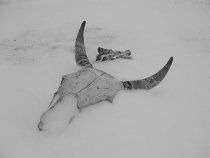Consequences of an unusually harsh winter in Mongolia
An unusually persistent and severe winter has caused the Red Cross to call for 1 million Swiss francs in emergency relief ($900,000).

 In Mongolia, an unusually persistent and severe winter has caused the Red Cross to call for 1 million Swiss francs in emergency relief ($900,000). Summer droughts and heavy winter snow made a deadly combination of depleted grass-stores and inaccessible grazing.
In Mongolia, an unusually persistent and severe winter has caused the Red Cross to call for 1 million Swiss francs in emergency relief ($900,000). Summer droughts and heavy winter snow made a deadly combination of depleted grass-stores and inaccessible grazing.
Since December, 4.5 million animals have died-this accounts for nearly 10% of Mongolia entire animal population. Some families have lost their entire herd, while those that consider themselves lucky have only retained 60% of their livestock. 3 million people in Mongolia live as nomadic herders.
Mongolia's economy depends almost exclusively on agriculture and mining and figures to be hit hard by this winter effect known as the 'zud' in Mongolian. The harsh winter is a common Mongolian phenomenon but this winter's zud has been the harshest since 1945, where the zud claimed the life of 7 million animals. Pain has most strongly affected the country's most vulnerable and impoverished people-currently flocking to slums in the Mongolian capital of Ulan Bator in hope of attaining emergency services.
No single weather event defines climate change. However, this harsh zud undeniably fits into the models climate scientists have proposed. Droughts increased in the summer, the winter was colder and harsher, and the world's poorest were forced to should the burden. The effects of the winter have put the Mongolian government and economy into an icy chokehold. The UN estimates nearly $60 million have been already been lost, which doesn't account for the major costs of emergency relief.
Author: Michael Good | Climate Action
Image Provided by: yeowatzup


_400_250_s_c1.png)



